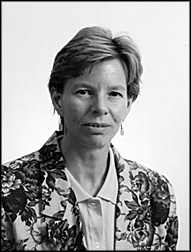Cherry Murray Pursues Excellence in Industrial Research

Ironically, Murray had always expected to become an artist, thanks to the influence of her parents, both of whom earned degrees in fine arts and met at an artist's colony in Taos, NM. Her father also holds a degree in English literature, and was an English teacher and headmaster of a private school prior to embarking on a diplomatic career after a stint in the US Army during World War II. The family moved constantly around the world thereafter.
Despite her enjoyment of lessons in piano, dance and art, Murray credits her brother, John, nine years her senior, with first piquing her interest in physics at the age of 6 when he decided to study physics during the height of the Sputnik Era. [He is now a research physicist at Lawrence Livermore National Laboratory.] A chemistry teacher at her high school in Alexandria, Virginia, encouraged her abilities in physical chemistry and physics, and when the family subsequently moved to Korea, she studied calculus and physics on her own because the US embassy school was so small. John also played a pivotal role in her decision to study physics at the Massachusetts Institute of Technology by insisting she would never survive the rigorous course of study. "So of course, I had to do it," says Murray, who earned her B.S. in physics from MIT in 1973 and won a scholarship to pursue graduate work there.
It was during her first year of graduate study that Murray was first exposed to physics in industry, when she elected to take a summer internship at Bell Laboratories, working on plasma physics. The experience "absolutely changed my view of what one could do as a career in physics," she says. "That's really why I'm at Bell Labs today." She considers the company to be one of the best places for doing cutting-edge research in condensed matter physics, while simultaneously having an impact on technology and business in general.
Murray received her PhD in physics from MIT in 1978, and promptly joined the technical staff at Bell Labs, becoming a distinguished member in 1985. She subsequently headed the Low Temperature and Solid State Research Department, the Condensed Matter Physics Research Department, and the Semiconductor Physics Department before assuming her present position in June 1997. The Physical Research Laboratory has approximately 100 researchers in fundamental physics, biophysics, chemistry and materials science, as well as thrusts in applied physics and materials, devices and circuits for high-speed optoelectronics, leading to inventions and innovations for future communications and microelectronics technologies of importance to Lucent Technologies.
Murray's own research program currently encompasses imaging of order-disorder transitions in colloidal crystals, self-assembly of optical materials, and Raman scattering from very small monodisperse silicon quantum dots. In 1989, she received the APS Maria Goeppert-Mayer Award for the experimental methods she used to discover "two stage" melting in two-dimensional arrays of colloidal polystyrene spheres, singled out particularly for her elucidation of the role that defects play in this phenomenon, as well as the connection between her discovery and recent theories of melting in two dimensions.
Although her own graduate experiences were highly positive, Murray cautions aspiring young women physicists to choose their school carefully, particularly if they wish to study with specific professors at smaller schools. "If you know exactly what you want to do, and who you want to work for, make sure that they're available and will be able to take you on as a student," she says. But the most important advice she would give is to find a good mentor, citing as an example the efforts of Mildred Dresselhaus, a professor of electrical engineering at MIT, who organizes seminar series for graduate students to give talks on their research topics.
Murray herself has volunteered as a mentor for several physics graduate students, in addition to participating in a hands-on science program at a local junior high school to encourage students to pursue careers in physics. Within the APS, she has held several positions in APS divisions, served on the executive committees of the Forums on Education and Industrial and Applied Physics, and on the Panel on Public Affairs, as well as various prize and fellowship committees. She is currently vice-chair of the APS Pake Prize Committee.
Despite her considerable professional commitments and volunteer work, Murray has still found time to marry and raise a family. She has a son, age 11, and a daughter, age 6, and credits the availability of an excellent child care center in New Jersey with making her dual role much easier. "It's usually child care arrangements that are the difficulty," she says. "I was very fortunate that the center had openings for both my children." She even occasionally finds time play the piano and take dance classes to keep physically active.
While she can envision one day obtaining a position as a university professor having an impact on the field by producing excellent students, she finds her current position far too challenging and enjoyable to consider changing career paths any time soon. "Someone described my new job as trying to drink from a fire hose, with things flying at you all the time, but I enjoy that kind of challenge," she says. "I definitely enjoy management and having an impact by working in industry, so I see myself doing this for a while."
©1995 - 2024, AMERICAN PHYSICAL SOCIETY
APS encourages the redistribution of the materials included in this newspaper provided that attribution to the source is noted and the materials are not truncated or changed.
February 1998 (Volume 7, Number 2)
Articles in this Issue

